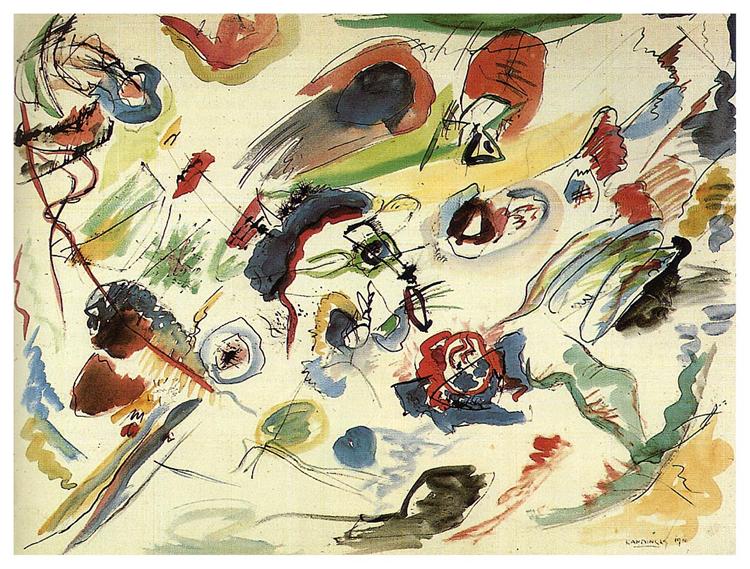Description
The work "Without title (first abstract watercolor)" by Wassily Kandinsky, created in 1910, is erected as a milestone in the history of modern art, marking one of the first steps towards full abstraction. This watercolor is not only a visual essay of color and shape, but also enrolls in the context of an artistic revolution in which Kandinsky, fundamental as theoretical and practitioner, sought to transcend the figurative representation to reach the essence of spiritual experience through art.
When observing the work, one is immediately attracted to its dynamic composition and the fluidity in which the colors are intertwined. The watercolor presents an amalgam of shapes and colors that seem to vibrate in unison, although they may lack a recognizable order. In this sense, Kandinsky moves away from the natural and representative environment, allowing emotion and intuition to guide his creation. This strategy is not accidental: Kandinsky had been deeply influenced by his interest in music, and sought to design a painting that evoked a visual symphony.
The color palette used in this work is rich and varied, with shades that go from deep blue to bright yellow, through intense green and red. These colors are not only chosen by their hue, but by the emotional burden they transmit. Each seems to dance on the surface of the paper, echoing the theory that Kandinsky himself defended: the idea that colors can cause an emotional response in the viewer, similar to that produced by music.
It is interesting to point out the absence of figures and characters in this painting, a distinctive feature of the transition to the abstraction that Kandinsky embraced in his work of this era. The presence of organic and geometric forms, although indistinct in terms of typical narratives, invites the viewer to actively participate in the interpretation of the work. Here, the viewer becomes a co-creator, giving meaning through his own emotional and perceptual experience.
The watercolor "Without title" also reflects Kandinsky's search to establish a connection between spirituality and art. In his essay "of the spiritual in art", the artist argued that art should communicate at a level beyond the visual, resonating in the soul of the viewer. This work is a palpable example of that philosophy, encapsulating an internal dialogue that transcends mere visual representation.
The fact that this watercolor is among the first manifestations of abstract art highlights its historical importance. Although it was not Kandinsky's first abstract work his most famous work in this regard is "VII composition", later created "without title (first abstract watercolor)" represents a crucial inflection point. From this moment on, modern art began to free itself from the chains of mimetic representation, proposing new ways of understanding visual and emotional experience.
In conclusion, "without title (first abstract watercolor)" is much more than a simple exercise of shape and color; It is a statement of intentions, an exploration of what art can become. Through its experimenter use of watercolor, Kandinsky left an indelible mark on the artistic scene, inviting future generations to reflect on the power of abstraction and its ability to connect with the depths of the human being. In this sense, the work is not only a testimony of Kandinsky's individual talent, but also a lighthouse that guides us towards new ways of perceiving and experiencing art.
KUADROS ©, a famous paint on your wall.
Hand-made oil painting reproductions, with the quality of professional artists and the distinctive seal of KUADROS ©.
Art reproduction service with satisfaction guarantee. If you are not completely satisfied with the replica of your painting, we refund your money 100%.

